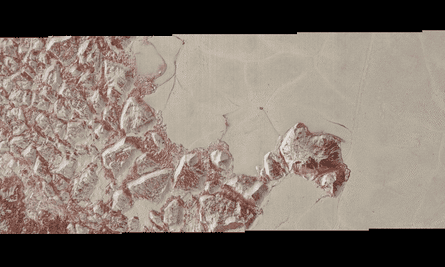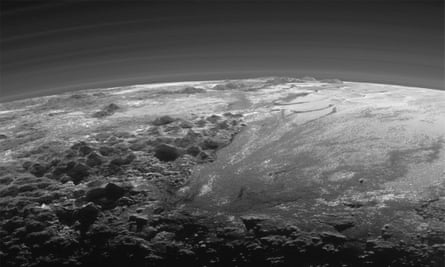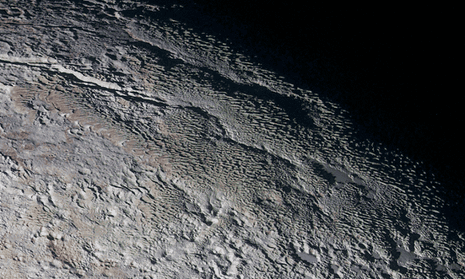The newest images and data from Pluto continue to astound Nasa scientists, lead researcher Alan Stern said on Monday, telling a university hall that “2015 will be a year in textbooks forever” as the point when mankind unveiled the world on the edge of its solar system.
“This world is alive,” Stern said of Pluto to a packed room at the University of Alberta. “It has weather, it has hazes in the atmosphere, active geology.”
Last week Nasa released its highest resolution photos yet of the dwarf planet and its largest moon, Charon, revealing new mysteries that its spacecraft New Horizons had uncovered at the edge of the solar system.
The space agency plans to unveil new data and images on Thursday. “Every week I am floored,” Stern said. “Nasa won’t let me tell you what we’re going to tell you on Thursday. It’s amazing.”
Charon’s dark red pole poses an enigma to scientists, Stern said, admitting “we don’t know anything like it in the solar system. We don’t know if it’s a stain, if it’s a material or something else.”
The moon shows a variety of terrains, including a canyon that runs 1,500 miles across the moon’s face, four times larger than the Grand Canyon and in places at least twice as deep as the American gorge, which cuts a mile into the earth on average.
“It looks like the entire crust of Charon has been split open,” John Spencer, deputy lead scientist on the geology and geophysics imaging team, said in a statement. The photos also show relatively smooth, crater-less plains south of the canyon, with ridges and grooves that suggest a varied and recently active surface, rather than the typical moon pockmarked with craters that many scientists had expected.
The researchers have at least one theory for what could have caused the surface to shift and change on a world so far from the sun: cold volcanoes driven by an internal ocean, a system known as cryovolcanism.
“An internal water ocean could have frozen long ago, and the resulting volume change could have led to Charon cracking open, allowing water-based lavas to reach the surface at that time,” Paul Schenk, a New Horizons researcher, said in the statement.

Similarly, recent images from Pluto continue to bemuse and delight the researchers. One photo shows a bizarre landscape of rolling and grooved mountains, about 330 miles across, nicknamed the “snakeskin” by Nasa scientists and described by Bill McKinnon, a Nasa geology and geophysics researcher, as “more like tree bark or dragon scales than geology”.
The ridges, vertically aligned and hundreds of meters tall, could be eroded material or structures that somehow grew out of the planet, Stern said. “They’re like flatirons on the side of mountains. We’ve never seen anything like that elsewhere on any of the planets or their satellites.”
McKinnon said the researchers could not be sure what caused the ridges, but that the mountains could have been caused by internal forces as well as ice sublimating into gas as it sunlight finally reaches Pluto, which is on average more than 3.67bn miles away.
Recent photos also show what Stern called “vast fields of features that look like dunes”, the shore of a disappearing glacial lake, and the fractured and steep cliffs of water ice mountains. Pluto’s atmosphere is currently too thin for any wind to shape dunes from the world’s open plains, meaning the origin of the fields – which could be made of volatile ice, sediment, tiny rock shards or something else – remains unknown.
The field of ice may rest within a giant crater, according to one theory mentioned by Sterns, or liquid nitrogen may be flowing beneath the plains, moving viscous and smooth under the splintered glaciers. Other features on the dwarf planet suggest a time when Pluto had a stronger atmosphere that could support “running rivers of nitrogen”, Sterns said.

Newly downloaded images also revealed a startling array of colors all over the dwarf planet. On the snakeskin mountains, informally named Tartarus Dorsa, the rippled pattern of ridges and troughs alternates between blue-gray heights and reddish material, possibly sediment, in the grooves between.
Spencer said the surface showed “a rainbow of pale blues, yellows, oranges and deep reds”, and that “many landforms have their own distinct colors”, each a potential clue about the landscape’s origins.
Data downloaded in September have set other puzzles for the researchers as well. The wide plain pitted with dunelike scallops, known to the scientists as Sputnik Planum, has a high concentration of methane, while the southern region called Cthulhu Regio has virtually none except in a few ridges and craters.
Researcher Will Grundy said the scientists at this point do not know whether the odd pattern was because methane is more likely to condense in the plains and crater rims, or whether the methane ice itself brightens those regions.

New Horizons became the first spacecraft to reach Pluto in July, after a nine-year journey, and the gradual download of photos and data since then has confounded and elated the probe’s Nasa creators on Earth. Images have shown valleys veined with trenches and dotted by hills, evidence of nitrogen snow and dynamic, shifting terrain, and enigmas of glacier-like flows, massive ice mountains and a reddish atmospheric fog.
Only a little more than 10% of the data about Pluto and its moons have been downloaded so far, Stern said.
The spacecraft is now more than 3bn miles away from Earth and heading into the Kuiper belt, toward an object dubbed PT1 – “potential target one” – on the edge of the solar system.
“It’ll get a better name,” Stern promised, adding that New Horizons, should it stay healthy, could run on its plutonium fuel into the 2030s. “Sometimes I hope I’m operating in the 2030s.”

Comments (…)
Sign in or create your Guardian account to join the discussion